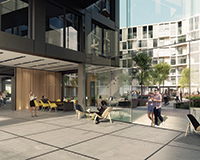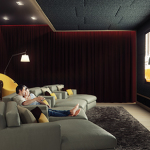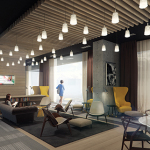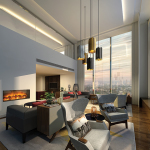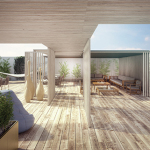In the burgeoning build-to-rent market, no one worth their salt enters the sector without a clear line on amenity provision. Communal lounges, kitchens and dining rooms sit alongside dog-grooming areas, gardens, gyms and crèches. If you’re not talking about customer satisfaction, you’re not doing it right.
Across the pond in the US, where the multifamily housing sector has more than 18m units under management, amenities are a key way of retaining tenants, upping rents and differentiating yourself from the competition.
UK operators, surveying the drab and amateurish UK rental landscape, have looked at this with dollar bills in their eyes.
But will it work in the UK? At the moment, we don’t know, because actual purpose-built, designed-from-the-ground-up PRS schemes are few and
far between. And are UK renters willing to pay for this?
Fleshed out or bare bones?
There are models emerging at either end of the UK PRS market.
At one end, the likes of Apache and Essential Living are providing a considerable level of amenity in their developments, from communal living rooms to gyms and cinemas.
According to Richard Jackson, managing director of Apache Capital Partners, this builds on what it has done in the student and care sectors: taking a long-term view on returns and a slightly lower development profit, with the view that as the sector matures, a premium will emerge.
At the other end of the scale, the likes of Fizzy Living are providing a more scaled back service, which bucks the trend, says managing director Harry Downes.
“Perceived wisdom is that we should be taking the lead from the US model, where indoor pools, gyms, guest suites, office amenities and even a car wash are the norm,” he says. But all of these amenities cost money, which one way or another comes from the tenants.
“Fizzy has 500 tenants,” says Downes. “Their average age is 31, and their average annual salary is £44,000. Their feedback is that they want value for money, and that means paying only for amenities they will actually use.”
Fizzy provides broadband free of charge, communal outside space and regular parties for residents. Other add-ons, such as furniture rental, are extra.
Although there is much talk of an amenities “arms race”, there is also a perception that the UK needs to find its own way.
“In the US, we see everything,” says John Badman, director at Callison RTKL, a stateside architectural practice that is now heavily involved in the UK market.
“We have the golf room, the billiard room, storage, dog-walking facilities and a spa. But I have always believed the UK is quite different from the US,” he says.
“The main difference is the maturity of the markets. The US cities have kit on the ground, and it’s a bit of an arms race, but here the assets do not yet exist.”
This is a sentiment that Andrew Stanford, residential fund manager at LaSalle Investment Management and former head of the government’s PRS task force, agrees with.
“I enjoy looking at the US multifamily model, but there is a clear danger of getting carried away, certainly when looking at cost versus benefit,” he says.
What is known?
While there has been research about what tenants want, there is, as yet, little concrete evidence that people will pay more for amenities.
Focus groups and market testing have been used to gauge what people want and what should be provided. The likes of Essential Living and Wilmott Dixon have conducted testing through focus groups, as has Westrock.
Dominic Martin, operations and strategy director at Westrock, says: “After doing extensive research and getting feedback from focus groups, we have identified our target market to be time-sensitive, tech-savvy professionals.
“Our strategy is all geared around convenience. Therefore, our residents have a gym in their building, a concierge they can go to directly, and an app to monitor and control almost everything.”
Meanwhile, Knight Frank research shows that 33% of tenants are willing to pay more for amenities, but this falls well below the 47% who rate good transport links, and the 52% who rate proximity to work, as the prime factors in choosing a place to rent.
But none of this proves – as a functioning rental development will – what, if any, premium will be obtained. It is all conjecture until schemes are built and tenants move in.
Jason Hardman, senior director at CBRE, says: “At this point, there is probably insufficient hard data to determine the level of rental premium that particular types of amenities
might achieve.
“Logic would suggest that for some locations, premium rents will be closely linked to particular types of product level or service. However, only when the market matures will we be able to fully analyse just how much extra income can be commanded by amenities such as gyms or pools.”
Can amenities make more money?
As a result, developers must be careful not to overdevelop and provide facilities that will not command a higher rent. Being flexible, and giving thought to viability, will be key.
“The challenge is predicting just how these things will play out, because the impact of amenities in the UK market in supporting and creating value is largely unknown,” says Mark Farmer, chief executive officer at Cast.
“Coming to the right decision about what to install is about combining financial modelling with design expertise and gauging likely consumer sentiment.”
It will also be essential to judge amenity provision on a scheme-by-scheme basis. Providers will have to determine what can be included and whether it will add value.
“We are taking the approach – a pretty pragmatic one – that one size does not fit all, and that every scheme, location and deal is different, at this stage of the sector’s development,” says Stanford.
“The only overriding point is that we will be pursuing purchases that satisfy our investment returns. If these are not met, we will not buy.”
Badman adds: “There are various strategies. Some are all-out, some more reserved. We are advising developers to be flexible, so that the building can be adapted as tenant trends, technology and attitudes to living change.”
RTKL has even designed schemes that allow homes to be converted into utilities, or vice versa, depending on what is needed.
Reducing churn
Many amenities are being included not to command premium rents, but to reduce tenant churn or to differentiate one scheme from the competition.
“We are not doing it to get punchier rents,” says Guy Butler, director at Glenbrook. “We are doing it to
reduce voids.
“I don’t think a person will choose a scheme because it has a gym. What I think people will do is stay for longer in schemes with a gym. In my opinion, it’s all about building communities and getting people to stay for longer, trusting in the quality of the landlord.”
Even those at the higher end of the market are cautious. “I think that in the long term, we will benefit from it,” says Jackson. “Perhaps we will see a bit of a premium in rental levels, although this is not what we are factoring in. But we will benefit when increased competition comes into these cities.”
Happy environment
A key amenity for many, as opposed to mod cons, is a management service that results in a well-run, communal, happy residential environment.
“If there is a shortage of good-quality rental accommodation, there is an argument for just putting out good-quality flats that will be extremely well managed, rather than worrying about a gym,” says Toby Nicholson, director at Colliers International.
“Management is more significant than you might imagine. It’s about focusing on the quality of the space, and the concierge, rather than on the bells and whistles. It’s about getting the basics of the space correct to make happy buildings with high tenant retention.”
Jackson adds: “For us, amenities form part of a wider offering. All of that [the provision of amenities] is worthless if you do not have a high degree of service. And you do not have to spend a fortune. All the little things add up.”
So, it seems the safe money is on getting tenants to stay, differentiating yourself from the competition, and providing a spot-on management service, rather than offering particularly ground-breaking amenities.
Flexibility is key
As more PRS schemes come online, operators and developers will have more idea what occupiers want.
For the moment, there is a huge variation in offerings. In the future, flexibility will be essential.
As the UK carves its own way forward in developing the sector, much will become clearer.
Jonathan Northey, partner at DLA Piper, says: “From living walls, rooftop pools, demonstration kitchens and dog blocks, the UK has a long way to catch up with the US in multifamily amenities.
“But the UK is not the US, and will need to develop its own approach. And this will be driven by demand and experience.”
But all of this is based on the supposition that generation rent is really prepared to spend more on renting.







